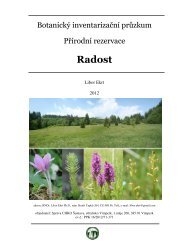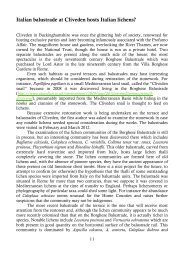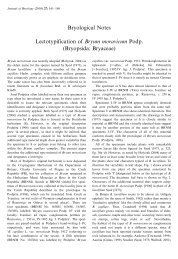Bryophyte flora of the Czech Republic: updated checklist and Red ...
Bryophyte flora of the Czech Republic: updated checklist and Red ...
Bryophyte flora of the Czech Republic: updated checklist and Red ...
Create successful ePaper yourself
Turn your PDF publications into a flip-book with our unique Google optimized e-Paper software.
814 Preslia 84: 813–850, 2012<br />
Methods<br />
For this compilation <strong>of</strong> an <strong>updated</strong> <strong>checklist</strong>, previous versions (Kučera & Váňa 2003,<br />
2005), which were based on extensive revisions <strong>of</strong> herbarium material <strong>of</strong> critical taxa,<br />
were used as a basis. With respect to nomenclature <strong>and</strong> taxonomic considerations, such as<br />
generic <strong>and</strong> specific concepts, we attempted to update our previous concepts in accordance<br />
with recent published results except for those cases for which <strong>the</strong> last published<br />
treatments still await a broader consensus (notably <strong>the</strong> moss order Hypnales <strong>and</strong> moss<br />
genera Bryum, Pohlia, Grimmia <strong>and</strong> Racomitrium). In <strong>the</strong> case <strong>of</strong> mosses, our treatment<br />
mostly follows <strong>the</strong> European <strong>checklist</strong> <strong>of</strong> Hill et al. (2006), with <strong>the</strong> eventual differences<br />
listed in <strong>the</strong> synonymy or to improve <strong>the</strong> underst<strong>and</strong>ing explicitly commented on. The differences<br />
from <strong>the</strong> last published complete European <strong>checklist</strong>s <strong>of</strong> liverworts <strong>and</strong> hornworts<br />
(Grolle & Long 2000, Söderström et al. 2002) were more numerous as a consequence<br />
<strong>of</strong> recent major systematic rearrangements based on <strong>the</strong> latest molecular studies.<br />
The name changes <strong>of</strong> hepatics particularly affected <strong>the</strong> earlier wide delimitation <strong>of</strong> <strong>the</strong><br />
genera Anastrophyllum, Jamesoniella, Jungermannia <strong>and</strong> Lophozia (Yatsentyuk et al.<br />
2004, de Roo et al. 2007, Konstantinova & Vilnet 2009, Feldberg et al. 2010a, 2010b,<br />
Vilnet et al. 2011, while <strong>the</strong> genus Apometzgeria is no longer recognized as different from<br />
Metzgeria (Fuselier et al. 2011), <strong>and</strong> some <strong>of</strong> <strong>the</strong> species <strong>of</strong> <strong>the</strong> earlier defined Marsupella<br />
were transferred to Gymnomitrion following <strong>the</strong> treatment by Váňa et al. (2010). In<br />
mosses, <strong>the</strong> changes in comparison with Hill et al. (2006) applied particularly to <strong>the</strong><br />
generic delimitations <strong>of</strong> Amblystegiaceae, Calliergonaceae (Hedenäs & Rosborg 2009,<br />
V<strong>and</strong>erpoorten & Hedenäs 2009, Hedenäs 2011) <strong>and</strong> Neckeraceae (Olsson et al. 2011)<br />
<strong>and</strong> in addition different generic concepts applied to Lescuraea, Hygrohypnum <strong>and</strong><br />
Campylophyllum, following Ignatov et al. (2007), Polytrichastrum <strong>and</strong> Polytrichum (Bell<br />
& Hyvönen 2010), Dicranoweisia (Ochyra et al. 2003), Barbula (Köckinger & Kučera<br />
2011) <strong>and</strong> Tortula, which we underst<strong>and</strong> to include Phascum <strong>and</strong> Protobryum. O<strong>the</strong>r<br />
minor changes are commented on under individual taxa. For <strong>the</strong> ease <strong>of</strong> orientation, we<br />
have included cross-references (following <strong>the</strong> ⇒ sign) to generic names that differ from<br />
those used in <strong>the</strong> previous version <strong>and</strong> to <strong>the</strong> <strong>checklist</strong> <strong>of</strong> European mosses.<br />
Author citations are mostly those used in previous versions <strong>of</strong> our <strong>checklist</strong>s, over<br />
which much effort was spent tracing <strong>the</strong> correct spelling in cases when <strong>the</strong> commonly used<br />
authoritative sources (Index Muscorum, Index Hepaticarum, Grolle & Long 2000, Ochyra<br />
et al. 2003) differed. We have newly adopted <strong>the</strong> convention <strong>of</strong> Hill et al. 2006 <strong>of</strong> not citing<br />
<strong>the</strong> pre-Hedwigian names validated by Hedwig (1801). One new combination is proposed<br />
below.<br />
The process by which we evaluated our taxa against <strong>the</strong> IUCN 3.1 criteria is described<br />
by Kučera & Váňa (2003). We continue to recognize <strong>the</strong> “Vanished” subcategory within<br />
Data Deficient taxa (DD-va), i.e. taxa not recorded for a long period <strong>of</strong> time (more than<br />
≈30 years) but with a realistic chance <strong>of</strong> being refound, ra<strong>the</strong>r than distributing <strong>the</strong>m into<br />
o<strong>the</strong>r categories, <strong>and</strong> <strong>the</strong> ‘attention list’ as a subcategory <strong>of</strong> Least Concern taxa (LC-att),<br />
which we use for less well known taxa for which <strong>the</strong>re is limited information on <strong>the</strong>ir current<br />
distribution <strong>and</strong> <strong>the</strong> potential threat to <strong>the</strong>m. Such taxa need to be closely monitored in<br />
<strong>the</strong> future as <strong>the</strong>y might ei<strong>the</strong>r qualify for inclusion in <strong>the</strong> <strong>Red</strong> List in future versions <strong>of</strong> <strong>the</strong><br />
<strong>checklist</strong> or might prove not to be threatened.










